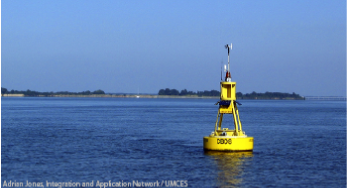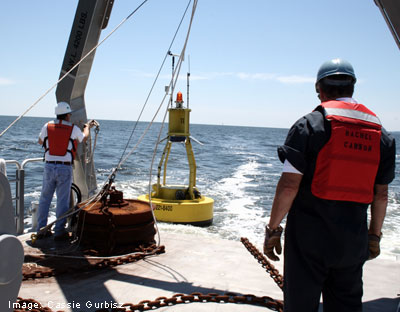 The ocean occupies over 70% of the Earth’s surface. Surface waters are constantly in motion, and these circulation patterns exert a strong effect on global and regional climate and weather. Winds set up by differences in solar heating drive the ocean’s surface currents. The Earth’s rotation (Coriolis effect) and coasts shape the circulation. The deep circulation of the global ocean is driven by density differences between the cold Polar Regions and the rest of the ocean. Warm, salty water delivered to the Polar Regions is cooled, forming dense water that sinks to the deeps and then spreads throughout the world ocean. The interaction between the atmosphere and the ocean creates year-to-year changes that can have strong effects on our weather. One of the better-known changes is El Nino/La Nina Southern Oscillation, (ENSO), which results from fluctuations in wind and ocean surface temperature. Now scientists use real-time data and information from ocean observing systems to interpret the ocean conditions and make predictions about weather and climate.
The ocean occupies over 70% of the Earth’s surface. Surface waters are constantly in motion, and these circulation patterns exert a strong effect on global and regional climate and weather. Winds set up by differences in solar heating drive the ocean’s surface currents. The Earth’s rotation (Coriolis effect) and coasts shape the circulation. The deep circulation of the global ocean is driven by density differences between the cold Polar Regions and the rest of the ocean. Warm, salty water delivered to the Polar Regions is cooled, forming dense water that sinks to the deeps and then spreads throughout the world ocean. The interaction between the atmosphere and the ocean creates year-to-year changes that can have strong effects on our weather. One of the better-known changes is El Nino/La Nina Southern Oscillation, (ENSO), which results from fluctuations in wind and ocean surface temperature. Now scientists use real-time data and information from ocean observing systems to interpret the ocean conditions and make predictions about weather and climate.
Objective
To explore the various parameters measured by ocean observing systems and become familiar with the websites which provide observing system data.
Materials
- Student Worksheet (download below)
- Computers with internet access
Procedure
Follow the directions below or download the student worksheet to explore the National Data Buoy Center website to familiarize yourself with ocean observing systems and the parameters they measure.
1. Divide into teams and define each parameter below by using web resources (Google, etc). Then go to the Ocean Observing Systems using the National Data Buoy Center website.
Click on an area nearest you. Choose a buoy and click on it. Record below the most recent data for each parameter at the buoy you chose. If your buoy doesn’t report on every parameter, click on other buoys to find one that does. You may not find any buoys reporting certain parameters.
Wind speed, gusts and direction
- Definition:
- Data values:
Temperature: Air & water
- Definition:
- Data values:
Pressure: Atmospheric, tendency
- Definition:
- Data values:
Tides/Water level
- Definition:
- Data values:
Waves: Height, period, direction
- Definition:
- Data values:
2. Go to Chesapeake Bay Eyes on the Bay website. Scroll down to the map of Chesapeake Bay and click on an orange buoy (these buoys measure data in real-time). Define each of the parameters below and record the most recent data values for each parameter.
Dissolved Oxygen Concentration
- Definition:
- Data values:
Salinity
- Definition:
- Data values:
Chlorophyll
- Definition:
- Data values:
3. Answer the questions below.
- What is the ocean temperature off the coast nearest your home or your favorite ocean area?
- What parameters were only available at a few buoys?
- Were you unable to find any parameters? Why do you think these parameters are not more widely measured?
Web Links
The following websites are used in this activity:
Chesapeake Bay Eyes on the Bay
